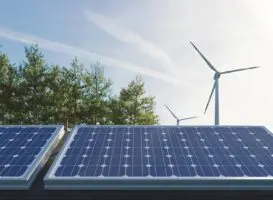The grant-making ARPA-E program was targeted for elimination in Trump budget.
After proposing to eliminate the Advanced Research Projects Agency-Energy (ARPA-E) in its draft budget, the Trump administration, through the Department of Energy, has started withholding money for grants already approved by the agency, Politico reported Thursday, citing two unidentified sources.
The hold on the money for the grants began last week, Politico reported. During his run for the White House, President Donald Trump promised to target federal funding for agencies, like ARPA-E, that promote clean energy technologies.
Trump’s “America First: A Blueprint to Make America Great Again,” released March 16, eliminates all funding for ARPA-E and and a similar agency for vehicle technology “because the private sector is better positioned to finance disruptive energy research and development and to commercialize innovative technologies.”
In response to Trump administration claims that the private sector is prepared to invest in these technologies, former ARPA-E director Ellen Williams insisted at a March conference that the agency “does not compete at a stage at which the private sector does R&D,” according to a Forbes news report. The agency is looking at funding early stage technologies “that are very high risk and allowing those technologies to compete … on an even playing field to move themselves forward on a pathway toward commercial assessment,” she said.
Just a week before Trump’s budget was released, Energy Secretary Rick Perry had publicly hailed the work of researchers who had received ARPA-E grants.
Innovators like the ones supported by our @ARPAE program are key to advancing America’s energy economy. https://t.co/agrkVnM217
— Rick Perry (@SecretaryPerry) March 8, 2017
DOE, ARPA-E’s parent department, did not directly address the claims about the withholding of funds for already-approved grants. In a statement emailed to ThinkProgress on Thursday, a DOE spokesperson said, “As with any transition from administration to administration, we have undertaken a full review of all department programs, policies, and taxpayer-funded grants. This is nothing more than applying good governance principles to how these programs are being executed.”
Brad Townsend, associate director for energy innovation at the Bipartisan Policy Center’s Energy Project, told ThinkProgress that it’s not uncommon for DOE or other federal agencies to reevaluate programs when they come in, especially when the government is operating under a continuing resolution like it is now for fiscal year 2017.
“FY’17 funds being withheld is less than ideal but doesn’t raise any flags for me,” Townsend said. “What concerns me more is if you look at some of the FOAs [funding opportunity announcements] for FY’16 programs, there are funding announcements that have yet to be made and are already overdue… Those are dollars that have been appropriated and have to be spent.”
ARPA-E was a bipartisan initiative modeled on the Department of Defense’s Department of Advanced Research Agency. The agency was designed to focus on helping the United States gain a competitive advantage in science and technology and look at ways to develop technologies that would provide economic, security, and environmental benefits.
The agency is focused on “high-impact, high-risk and high-reward” projects, Townsend noted, and he agreed with the former program director that these are areas in which the private sector likely would not invest. For example, researchers for a group called Makani Power created a wind turbine project, funded by ARPA-E, that sends airborne kite-like wind turbines high into the air where they harness a more consistent and powerful wind source than earthbound wind turbines. Makani Power designed the drone kites to automatically take off and adjust themselves to the windstream to maximize energy production.
ARPA-E awarded Makani Power a $3 million grant in 2009 for the project. In 2013, Google X, the search engine company’s research and investment arm, acquired Makani Power, turning the research project into a success story for ARPA-E.
Google X reports the project is making the transition to a commercial product, According to an ARPA-E a 2016 project update. “Successful deployment and expansion of low-cost airborne wind power will create an entirely different technology for use of this renewable power source,” ARPA-E said. “By reducing geographic use restrictions, airborne wind farms will allow siting of wind generation in locations closer to population centers and where the existing transmission and distribution lines can be used effectively.”
The agency has funded about 580 projects since it was founded in 2009 as part of President Barack Obama’s American Recovery and Reinvestment Act. The agency reportedly has provided more than $1.5 billion in funds for more than 500 projects, which have attracted $1.8 billion in private sector funding.
“ARPA-E is filling a critical gap in the innovation cycle, and, frankly, they’re getting really good at it,” Townsend said.
ARPA-E’s grants have helped the recipient research teams to create 56 companies. The agency is working on technologies that will “change the game,” Townsend said. A great deal of corporate research tends to be focused on incremental research gain, while ARPA-E is “working to create entire new industries that have been at the heart of every wave of economic growth we’ve seen in this country since the second half of the 20th century,” he added.









